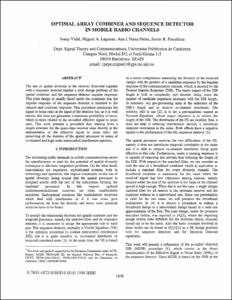Mostra el registre d'ítem simple
Optimal array combiner and sequence detector in mobile radio channels
| dc.contributor.author | Vidal Manzano, José |
| dc.contributor.author | Lagunas Hernandez, Miguel A. |
| dc.contributor.author | Pérez Neira, Ana Isabel |
| dc.contributor.author | Rodríguez Fonollosa, Javier |
| dc.contributor.other | Universitat Politècnica de Catalunya. Departament de Teoria del Senyal i Comunicacions |
| dc.date.accessioned | 2016-06-28T12:40:32Z |
| dc.date.available | 2016-06-28T12:40:32Z |
| dc.date.issued | 1998 |
| dc.identifier.citation | Vidal, J., Lagunas, M., Perez, A., R. Fonollosa, Javier. Optimal array combiner and sequence detector in mobile radio channels. A: IEEE Symposium on Personal Indoor and Mobile. "PIMRC 1998: the Ninth IEEE International Symposium on Personal, Indoor and Mobile Radio Communications: September 8-11, 1998: the Marriott Copley Place, Boston, Massachusetts: technical program proceedings". Boston, Massachusetts: 1998, p. 1270-1274. |
| dc.identifier.isbn | 0-7803-4999-7 |
| dc.identifier.uri | http://hdl.handle.net/2117/88348 |
| dc.description.abstract | The use of spatial diversity at the receiver front-end together with a sequence detector implies a joint design problem of the spatial combiner and the sequence detector impulse response. This joint design is usually faced under the constraint that the impulse response of the sequence detector is matched to the channel and combiner response. This procedure maximizes the signal to noise ratio at the input of the detector but, as it is well known, this does not guarantee a minimum probability of error, which is more related to the so-called effective signal to noise ratio. This work presents a procedure that, starting from a simple structure for the space-time receiver aims directly at the maximization of the effective signal to noise ratio, yet preserving all the features of the spatial processor in terms of co-channel and high order intersymbol interference rejection. |
| dc.format.extent | 5 p. |
| dc.language.iso | eng |
| dc.rights.uri | http://creativecommons.org/licenses/by-nc-nd/3.0/es/ |
| dc.subject | Àrees temàtiques de la UPC::Enginyeria de la telecomunicació |
| dc.subject | Àrees temàtiques de la UPC::Enginyeria de la telecomunicació::Radiocomunicació i exploració electromagnètica |
| dc.subject.lcsh | Radar--Interference |
| dc.subject.other | Cochannel interference |
| dc.subject.other | Diversity reception |
| dc.subject.other | Error statistics |
| dc.subject.other | Interference suppression |
| dc.title | Optimal array combiner and sequence detector in mobile radio channels |
| dc.type | Conference report |
| dc.subject.lemac | Radar--Interferències |
| dc.contributor.group | Universitat Politècnica de Catalunya. SPCOM - Grup de Recerca de Processament del Senyal i Comunicacions |
| dc.contributor.group | Universitat Politècnica de Catalunya. A&MP - Grup de Processament d'Arrays i Sistemes Multicanal |
| dc.identifier.doi | 10.1109/PIMRC.1998.731392 |
| dc.description.peerreviewed | Peer Reviewed |
| dc.relation.publisherversion | http://ieeexplore.ieee.org/stamp/stamp.jsp?tp=&arnumber=731392 |
| dc.rights.access | Open Access |
| local.identifier.drac | 2745746 |
| dc.description.version | Postprint (published version) |
| local.citation.author | Vidal, J.; Lagunas, M.; Perez, A.; R. Fonollosa, Javier |
| local.citation.contributor | IEEE Symposium on Personal Indoor and Mobile |
| local.citation.pubplace | Boston, Massachusetts |
| local.citation.publicationName | PIMRC 1998: the Ninth IEEE International Symposium on Personal, Indoor and Mobile Radio Communications: September 8-11, 1998: the Marriott Copley Place, Boston, Massachusetts: technical program proceedings |
| local.citation.startingPage | 1270 |
| local.citation.endingPage | 1274 |


